Tourism's Role in Poverty Alleviation: An Argumentative Essay
VerifiedAdded on 2021/04/24
|10
|2938
|21
Essay
AI Summary
This argumentative essay explores the impact of the tourism industry on poverty reduction, focusing on India as a case study. It examines the direct, indirect, and induced impacts of tourism, including its contribution to employment and foreign exchange, and its role in generating income. The essay supports the argument that tourism alleviates poverty, while also presenting counter-arguments, such as potential negative effects on local communities and the environment. The paper references the concept of pro-poor tourism and discusses its potential benefits, as well as the limitations of tourism as a tool for poverty reduction, considering both economic and socio-cultural factors, and the potential for employment distortion and the seasonal nature of tourism. The essay provides a comprehensive overview of the debate surrounding tourism's role in poverty alleviation.
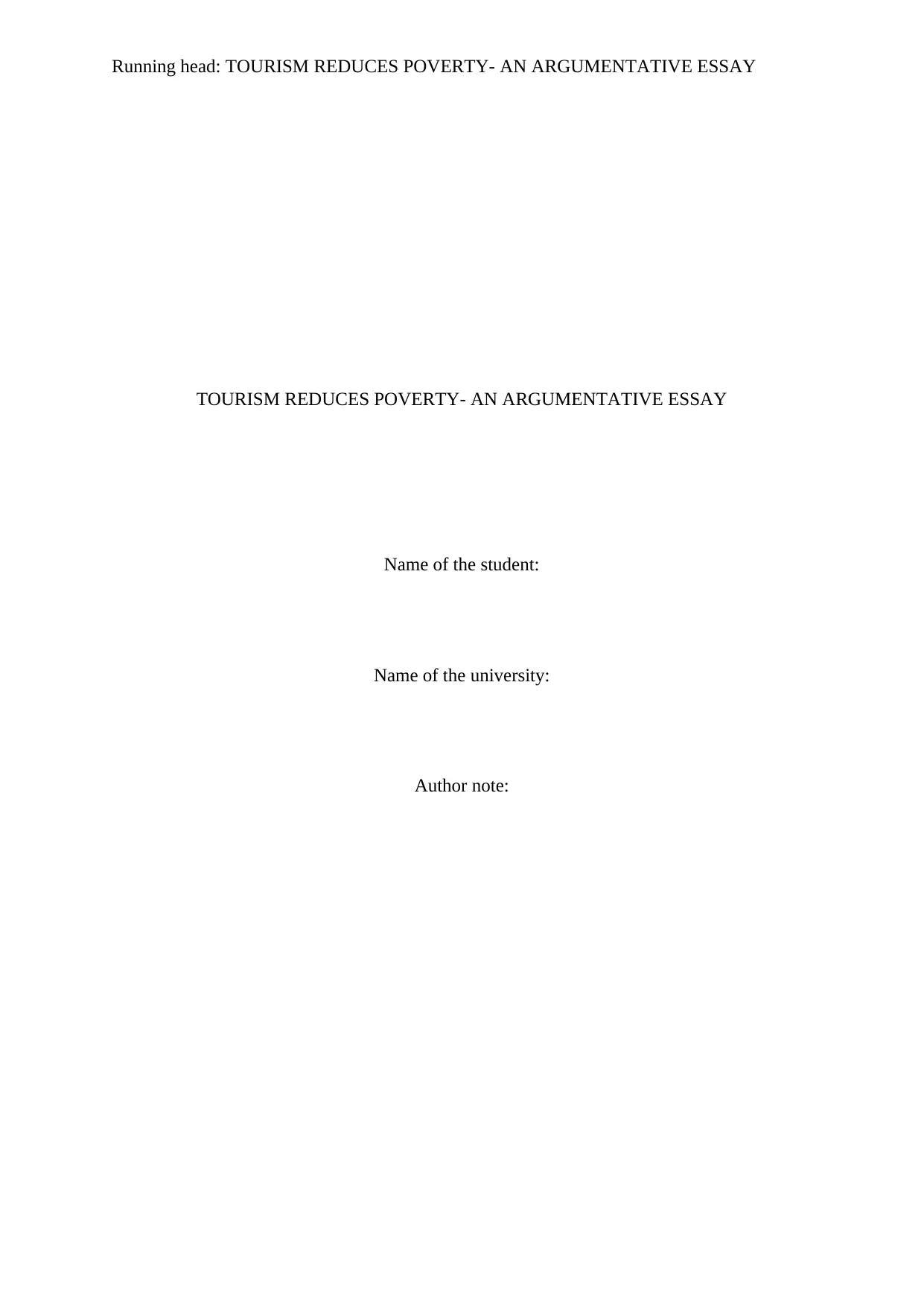
Running head: TOURISM REDUCES POVERTY- AN ARGUMENTATIVE ESSAY
TOURISM REDUCES POVERTY- AN ARGUMENTATIVE ESSAY
Name of the student:
Name of the university:
Author note:
TOURISM REDUCES POVERTY- AN ARGUMENTATIVE ESSAY
Name of the student:
Name of the university:
Author note:
Paraphrase This Document
Need a fresh take? Get an instant paraphrase of this document with our AI Paraphraser
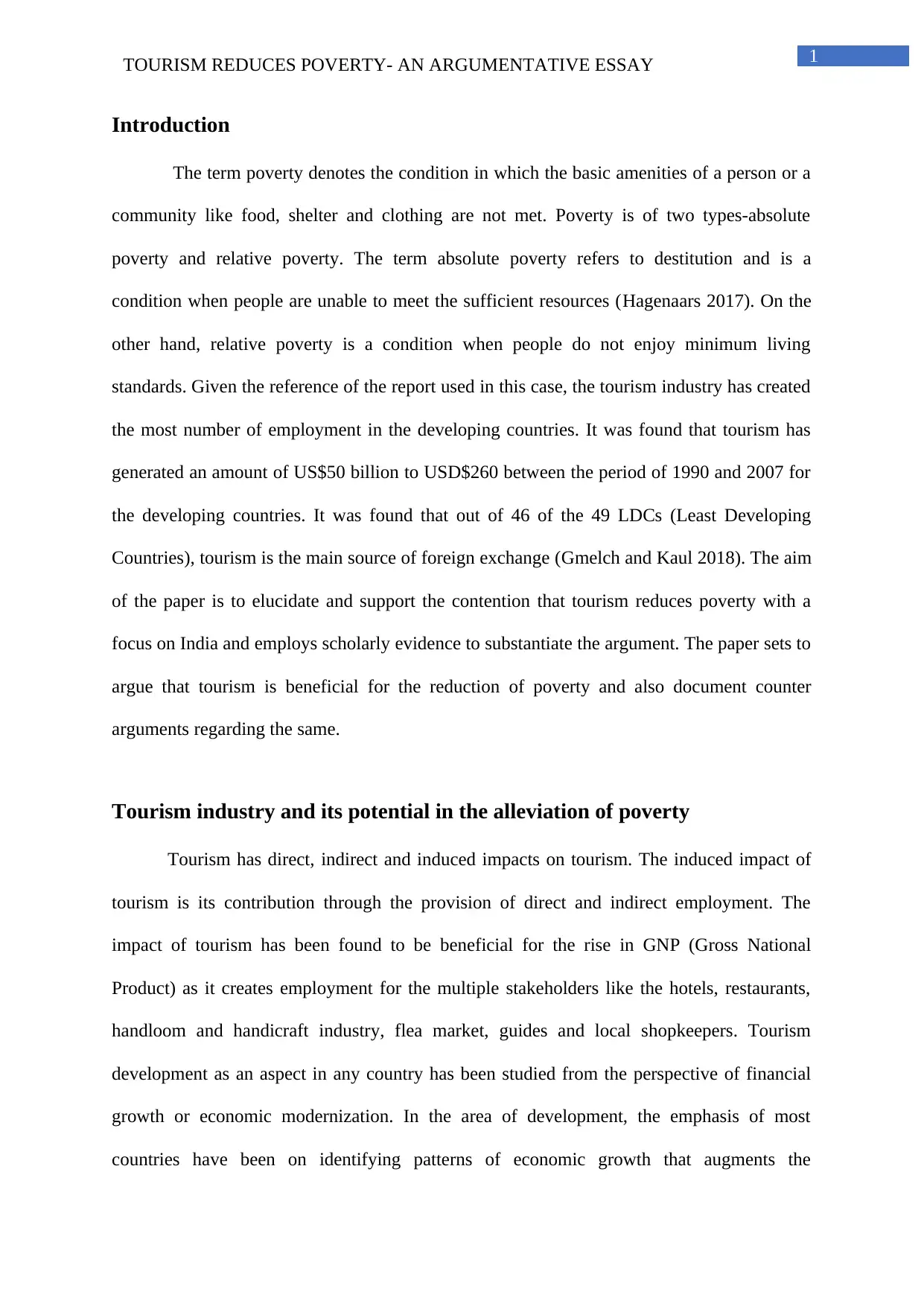
1TOURISM REDUCES POVERTY- AN ARGUMENTATIVE ESSAY
Introduction
The term poverty denotes the condition in which the basic amenities of a person or a
community like food, shelter and clothing are not met. Poverty is of two types-absolute
poverty and relative poverty. The term absolute poverty refers to destitution and is a
condition when people are unable to meet the sufficient resources (Hagenaars 2017). On the
other hand, relative poverty is a condition when people do not enjoy minimum living
standards. Given the reference of the report used in this case, the tourism industry has created
the most number of employment in the developing countries. It was found that tourism has
generated an amount of US$50 billion to USD$260 between the period of 1990 and 2007 for
the developing countries. It was found that out of 46 of the 49 LDCs (Least Developing
Countries), tourism is the main source of foreign exchange (Gmelch and Kaul 2018). The aim
of the paper is to elucidate and support the contention that tourism reduces poverty with a
focus on India and employs scholarly evidence to substantiate the argument. The paper sets to
argue that tourism is beneficial for the reduction of poverty and also document counter
arguments regarding the same.
Tourism industry and its potential in the alleviation of poverty
Tourism has direct, indirect and induced impacts on tourism. The induced impact of
tourism is its contribution through the provision of direct and indirect employment. The
impact of tourism has been found to be beneficial for the rise in GNP (Gross National
Product) as it creates employment for the multiple stakeholders like the hotels, restaurants,
handloom and handicraft industry, flea market, guides and local shopkeepers. Tourism
development as an aspect in any country has been studied from the perspective of financial
growth or economic modernization. In the area of development, the emphasis of most
countries have been on identifying patterns of economic growth that augments the
Introduction
The term poverty denotes the condition in which the basic amenities of a person or a
community like food, shelter and clothing are not met. Poverty is of two types-absolute
poverty and relative poverty. The term absolute poverty refers to destitution and is a
condition when people are unable to meet the sufficient resources (Hagenaars 2017). On the
other hand, relative poverty is a condition when people do not enjoy minimum living
standards. Given the reference of the report used in this case, the tourism industry has created
the most number of employment in the developing countries. It was found that tourism has
generated an amount of US$50 billion to USD$260 between the period of 1990 and 2007 for
the developing countries. It was found that out of 46 of the 49 LDCs (Least Developing
Countries), tourism is the main source of foreign exchange (Gmelch and Kaul 2018). The aim
of the paper is to elucidate and support the contention that tourism reduces poverty with a
focus on India and employs scholarly evidence to substantiate the argument. The paper sets to
argue that tourism is beneficial for the reduction of poverty and also document counter
arguments regarding the same.
Tourism industry and its potential in the alleviation of poverty
Tourism has direct, indirect and induced impacts on tourism. The induced impact of
tourism is its contribution through the provision of direct and indirect employment. The
impact of tourism has been found to be beneficial for the rise in GNP (Gross National
Product) as it creates employment for the multiple stakeholders like the hotels, restaurants,
handloom and handicraft industry, flea market, guides and local shopkeepers. Tourism
development as an aspect in any country has been studied from the perspective of financial
growth or economic modernization. In the area of development, the emphasis of most
countries have been on identifying patterns of economic growth that augments the
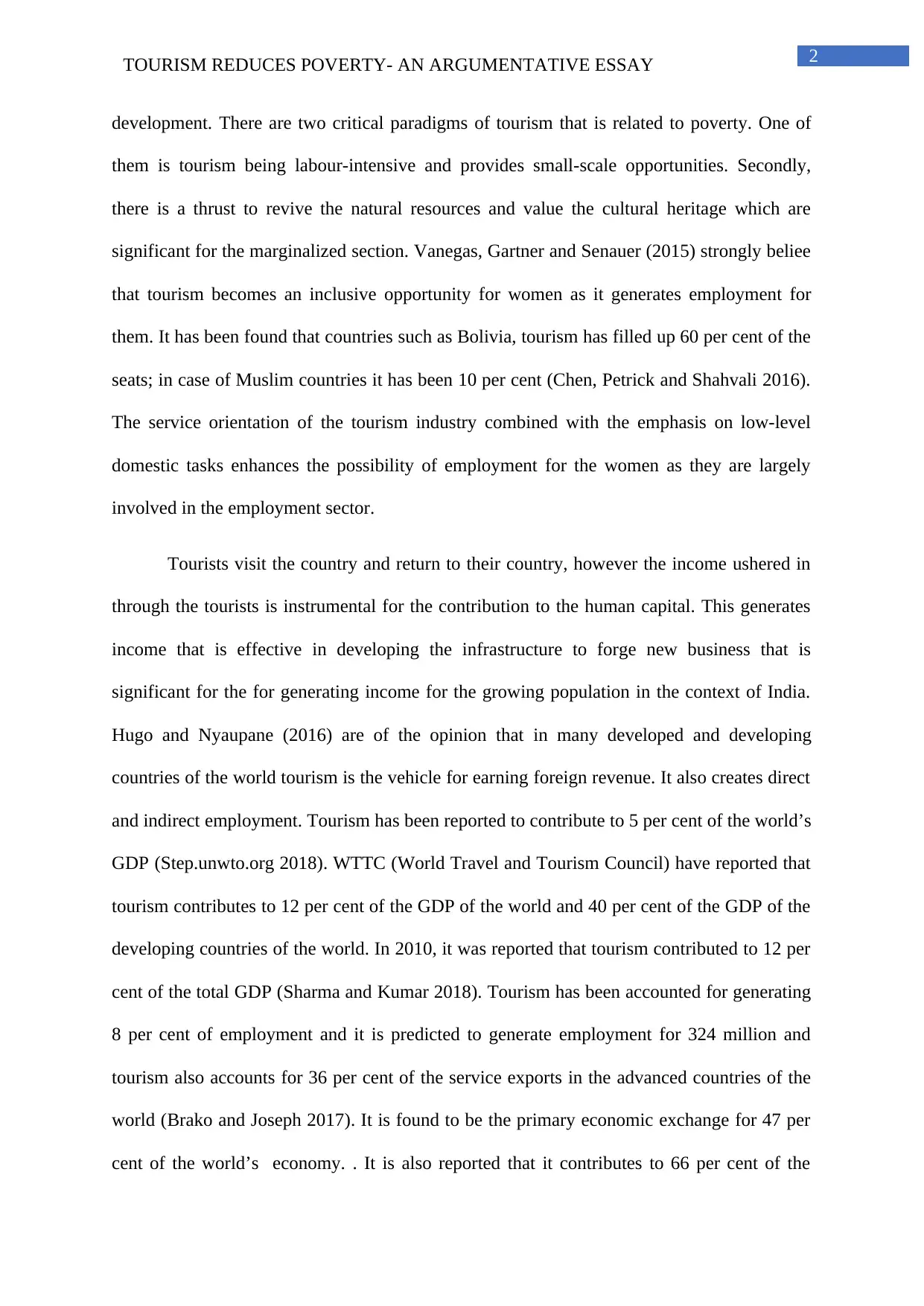
2TOURISM REDUCES POVERTY- AN ARGUMENTATIVE ESSAY
development. There are two critical paradigms of tourism that is related to poverty. One of
them is tourism being labour-intensive and provides small-scale opportunities. Secondly,
there is a thrust to revive the natural resources and value the cultural heritage which are
significant for the marginalized section. Vanegas, Gartner and Senauer (2015) strongly beliee
that tourism becomes an inclusive opportunity for women as it generates employment for
them. It has been found that countries such as Bolivia, tourism has filled up 60 per cent of the
seats; in case of Muslim countries it has been 10 per cent (Chen, Petrick and Shahvali 2016).
The service orientation of the tourism industry combined with the emphasis on low-level
domestic tasks enhances the possibility of employment for the women as they are largely
involved in the employment sector.
Tourists visit the country and return to their country, however the income ushered in
through the tourists is instrumental for the contribution to the human capital. This generates
income that is effective in developing the infrastructure to forge new business that is
significant for the for generating income for the growing population in the context of India.
Hugo and Nyaupane (2016) are of the opinion that in many developed and developing
countries of the world tourism is the vehicle for earning foreign revenue. It also creates direct
and indirect employment. Tourism has been reported to contribute to 5 per cent of the world’s
GDP (Step.unwto.org 2018). WTTC (World Travel and Tourism Council) have reported that
tourism contributes to 12 per cent of the GDP of the world and 40 per cent of the GDP of the
developing countries of the world. In 2010, it was reported that tourism contributed to 12 per
cent of the total GDP (Sharma and Kumar 2018). Tourism has been accounted for generating
8 per cent of employment and it is predicted to generate employment for 324 million and
tourism also accounts for 36 per cent of the service exports in the advanced countries of the
world (Brako and Joseph 2017). It is found to be the primary economic exchange for 47 per
cent of the world’s economy. . It is also reported that it contributes to 66 per cent of the
development. There are two critical paradigms of tourism that is related to poverty. One of
them is tourism being labour-intensive and provides small-scale opportunities. Secondly,
there is a thrust to revive the natural resources and value the cultural heritage which are
significant for the marginalized section. Vanegas, Gartner and Senauer (2015) strongly beliee
that tourism becomes an inclusive opportunity for women as it generates employment for
them. It has been found that countries such as Bolivia, tourism has filled up 60 per cent of the
seats; in case of Muslim countries it has been 10 per cent (Chen, Petrick and Shahvali 2016).
The service orientation of the tourism industry combined with the emphasis on low-level
domestic tasks enhances the possibility of employment for the women as they are largely
involved in the employment sector.
Tourists visit the country and return to their country, however the income ushered in
through the tourists is instrumental for the contribution to the human capital. This generates
income that is effective in developing the infrastructure to forge new business that is
significant for the for generating income for the growing population in the context of India.
Hugo and Nyaupane (2016) are of the opinion that in many developed and developing
countries of the world tourism is the vehicle for earning foreign revenue. It also creates direct
and indirect employment. Tourism has been reported to contribute to 5 per cent of the world’s
GDP (Step.unwto.org 2018). WTTC (World Travel and Tourism Council) have reported that
tourism contributes to 12 per cent of the GDP of the world and 40 per cent of the GDP of the
developing countries of the world. In 2010, it was reported that tourism contributed to 12 per
cent of the total GDP (Sharma and Kumar 2018). Tourism has been accounted for generating
8 per cent of employment and it is predicted to generate employment for 324 million and
tourism also accounts for 36 per cent of the service exports in the advanced countries of the
world (Brako and Joseph 2017). It is found to be the primary economic exchange for 47 per
cent of the world’s economy. . It is also reported that it contributes to 66 per cent of the
⊘ This is a preview!⊘
Do you want full access?
Subscribe today to unlock all pages.

Trusted by 1+ million students worldwide
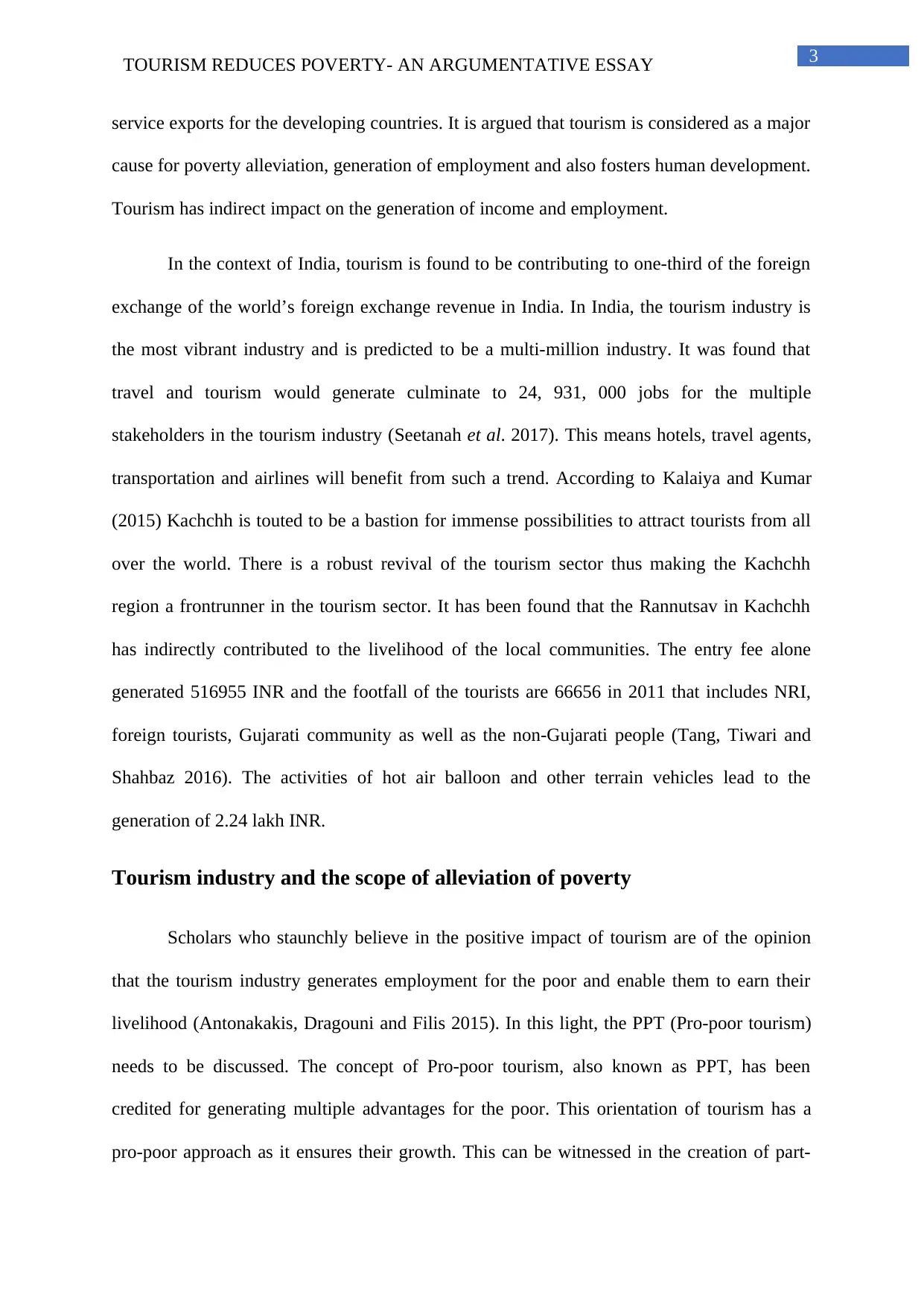
3TOURISM REDUCES POVERTY- AN ARGUMENTATIVE ESSAY
service exports for the developing countries. It is argued that tourism is considered as a major
cause for poverty alleviation, generation of employment and also fosters human development.
Tourism has indirect impact on the generation of income and employment.
In the context of India, tourism is found to be contributing to one-third of the foreign
exchange of the world’s foreign exchange revenue in India. In India, the tourism industry is
the most vibrant industry and is predicted to be a multi-million industry. It was found that
travel and tourism would generate culminate to 24, 931, 000 jobs for the multiple
stakeholders in the tourism industry (Seetanah et al. 2017). This means hotels, travel agents,
transportation and airlines will benefit from such a trend. According to Kalaiya and Kumar
(2015) Kachchh is touted to be a bastion for immense possibilities to attract tourists from all
over the world. There is a robust revival of the tourism sector thus making the Kachchh
region a frontrunner in the tourism sector. It has been found that the Rannutsav in Kachchh
has indirectly contributed to the livelihood of the local communities. The entry fee alone
generated 516955 INR and the footfall of the tourists are 66656 in 2011 that includes NRI,
foreign tourists, Gujarati community as well as the non-Gujarati people (Tang, Tiwari and
Shahbaz 2016). The activities of hot air balloon and other terrain vehicles lead to the
generation of 2.24 lakh INR.
Tourism industry and the scope of alleviation of poverty
Scholars who staunchly believe in the positive impact of tourism are of the opinion
that the tourism industry generates employment for the poor and enable them to earn their
livelihood (Antonakakis, Dragouni and Filis 2015). In this light, the PPT (Pro-poor tourism)
needs to be discussed. The concept of Pro-poor tourism, also known as PPT, has been
credited for generating multiple advantages for the poor. This orientation of tourism has a
pro-poor approach as it ensures their growth. This can be witnessed in the creation of part-
service exports for the developing countries. It is argued that tourism is considered as a major
cause for poverty alleviation, generation of employment and also fosters human development.
Tourism has indirect impact on the generation of income and employment.
In the context of India, tourism is found to be contributing to one-third of the foreign
exchange of the world’s foreign exchange revenue in India. In India, the tourism industry is
the most vibrant industry and is predicted to be a multi-million industry. It was found that
travel and tourism would generate culminate to 24, 931, 000 jobs for the multiple
stakeholders in the tourism industry (Seetanah et al. 2017). This means hotels, travel agents,
transportation and airlines will benefit from such a trend. According to Kalaiya and Kumar
(2015) Kachchh is touted to be a bastion for immense possibilities to attract tourists from all
over the world. There is a robust revival of the tourism sector thus making the Kachchh
region a frontrunner in the tourism sector. It has been found that the Rannutsav in Kachchh
has indirectly contributed to the livelihood of the local communities. The entry fee alone
generated 516955 INR and the footfall of the tourists are 66656 in 2011 that includes NRI,
foreign tourists, Gujarati community as well as the non-Gujarati people (Tang, Tiwari and
Shahbaz 2016). The activities of hot air balloon and other terrain vehicles lead to the
generation of 2.24 lakh INR.
Tourism industry and the scope of alleviation of poverty
Scholars who staunchly believe in the positive impact of tourism are of the opinion
that the tourism industry generates employment for the poor and enable them to earn their
livelihood (Antonakakis, Dragouni and Filis 2015). In this light, the PPT (Pro-poor tourism)
needs to be discussed. The concept of Pro-poor tourism, also known as PPT, has been
credited for generating multiple advantages for the poor. This orientation of tourism has a
pro-poor approach as it ensures their growth. This can be witnessed in the creation of part-
Paraphrase This Document
Need a fresh take? Get an instant paraphrase of this document with our AI Paraphraser
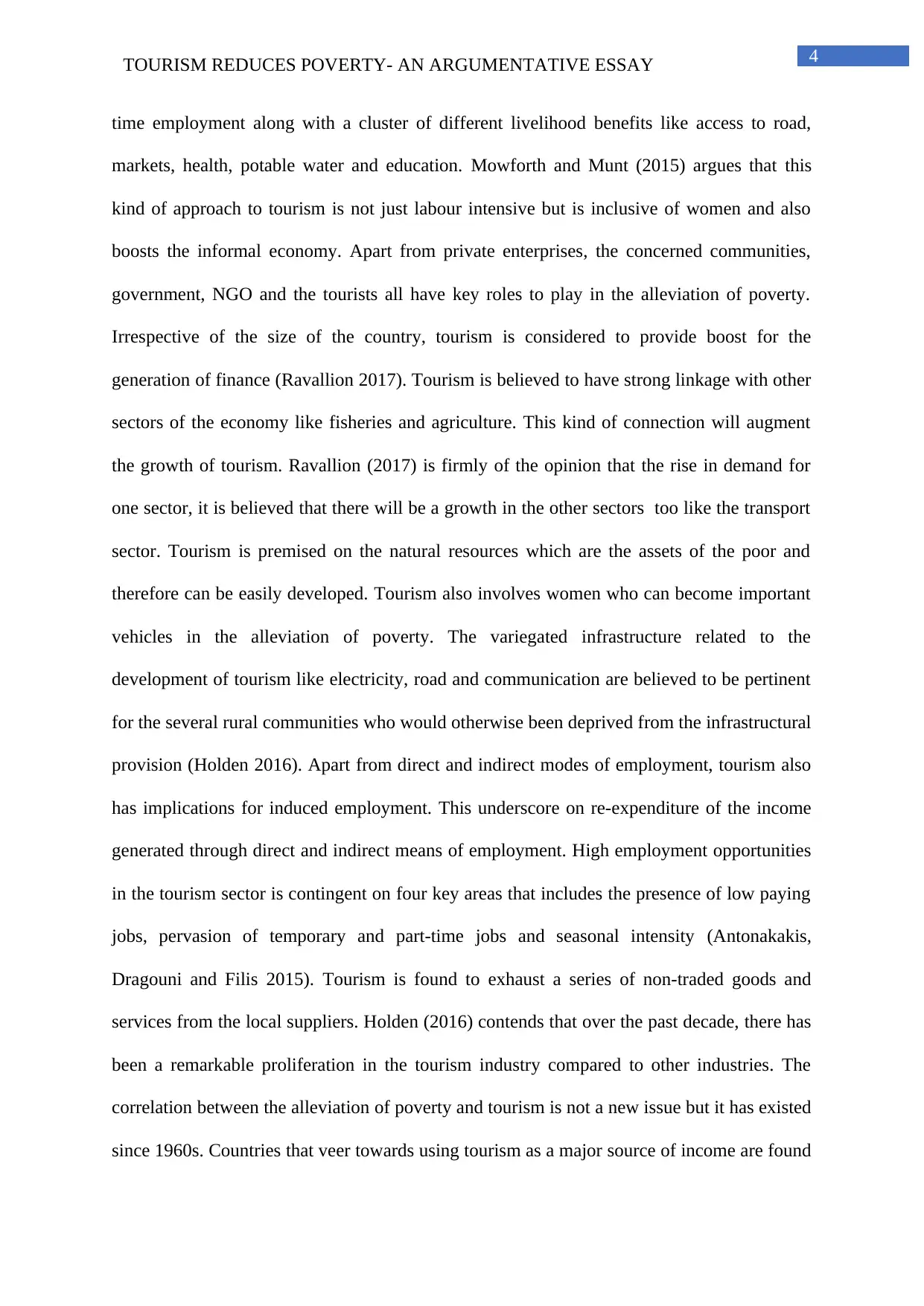
4TOURISM REDUCES POVERTY- AN ARGUMENTATIVE ESSAY
time employment along with a cluster of different livelihood benefits like access to road,
markets, health, potable water and education. Mowforth and Munt (2015) argues that this
kind of approach to tourism is not just labour intensive but is inclusive of women and also
boosts the informal economy. Apart from private enterprises, the concerned communities,
government, NGO and the tourists all have key roles to play in the alleviation of poverty.
Irrespective of the size of the country, tourism is considered to provide boost for the
generation of finance (Ravallion 2017). Tourism is believed to have strong linkage with other
sectors of the economy like fisheries and agriculture. This kind of connection will augment
the growth of tourism. Ravallion (2017) is firmly of the opinion that the rise in demand for
one sector, it is believed that there will be a growth in the other sectors too like the transport
sector. Tourism is premised on the natural resources which are the assets of the poor and
therefore can be easily developed. Tourism also involves women who can become important
vehicles in the alleviation of poverty. The variegated infrastructure related to the
development of tourism like electricity, road and communication are believed to be pertinent
for the several rural communities who would otherwise been deprived from the infrastructural
provision (Holden 2016). Apart from direct and indirect modes of employment, tourism also
has implications for induced employment. This underscore on re-expenditure of the income
generated through direct and indirect means of employment. High employment opportunities
in the tourism sector is contingent on four key areas that includes the presence of low paying
jobs, pervasion of temporary and part-time jobs and seasonal intensity (Antonakakis,
Dragouni and Filis 2015). Tourism is found to exhaust a series of non-traded goods and
services from the local suppliers. Holden (2016) contends that over the past decade, there has
been a remarkable proliferation in the tourism industry compared to other industries. The
correlation between the alleviation of poverty and tourism is not a new issue but it has existed
since 1960s. Countries that veer towards using tourism as a major source of income are found
time employment along with a cluster of different livelihood benefits like access to road,
markets, health, potable water and education. Mowforth and Munt (2015) argues that this
kind of approach to tourism is not just labour intensive but is inclusive of women and also
boosts the informal economy. Apart from private enterprises, the concerned communities,
government, NGO and the tourists all have key roles to play in the alleviation of poverty.
Irrespective of the size of the country, tourism is considered to provide boost for the
generation of finance (Ravallion 2017). Tourism is believed to have strong linkage with other
sectors of the economy like fisheries and agriculture. This kind of connection will augment
the growth of tourism. Ravallion (2017) is firmly of the opinion that the rise in demand for
one sector, it is believed that there will be a growth in the other sectors too like the transport
sector. Tourism is premised on the natural resources which are the assets of the poor and
therefore can be easily developed. Tourism also involves women who can become important
vehicles in the alleviation of poverty. The variegated infrastructure related to the
development of tourism like electricity, road and communication are believed to be pertinent
for the several rural communities who would otherwise been deprived from the infrastructural
provision (Holden 2016). Apart from direct and indirect modes of employment, tourism also
has implications for induced employment. This underscore on re-expenditure of the income
generated through direct and indirect means of employment. High employment opportunities
in the tourism sector is contingent on four key areas that includes the presence of low paying
jobs, pervasion of temporary and part-time jobs and seasonal intensity (Antonakakis,
Dragouni and Filis 2015). Tourism is found to exhaust a series of non-traded goods and
services from the local suppliers. Holden (2016) contends that over the past decade, there has
been a remarkable proliferation in the tourism industry compared to other industries. The
correlation between the alleviation of poverty and tourism is not a new issue but it has existed
since 1960s. Countries that veer towards using tourism as a major source of income are found
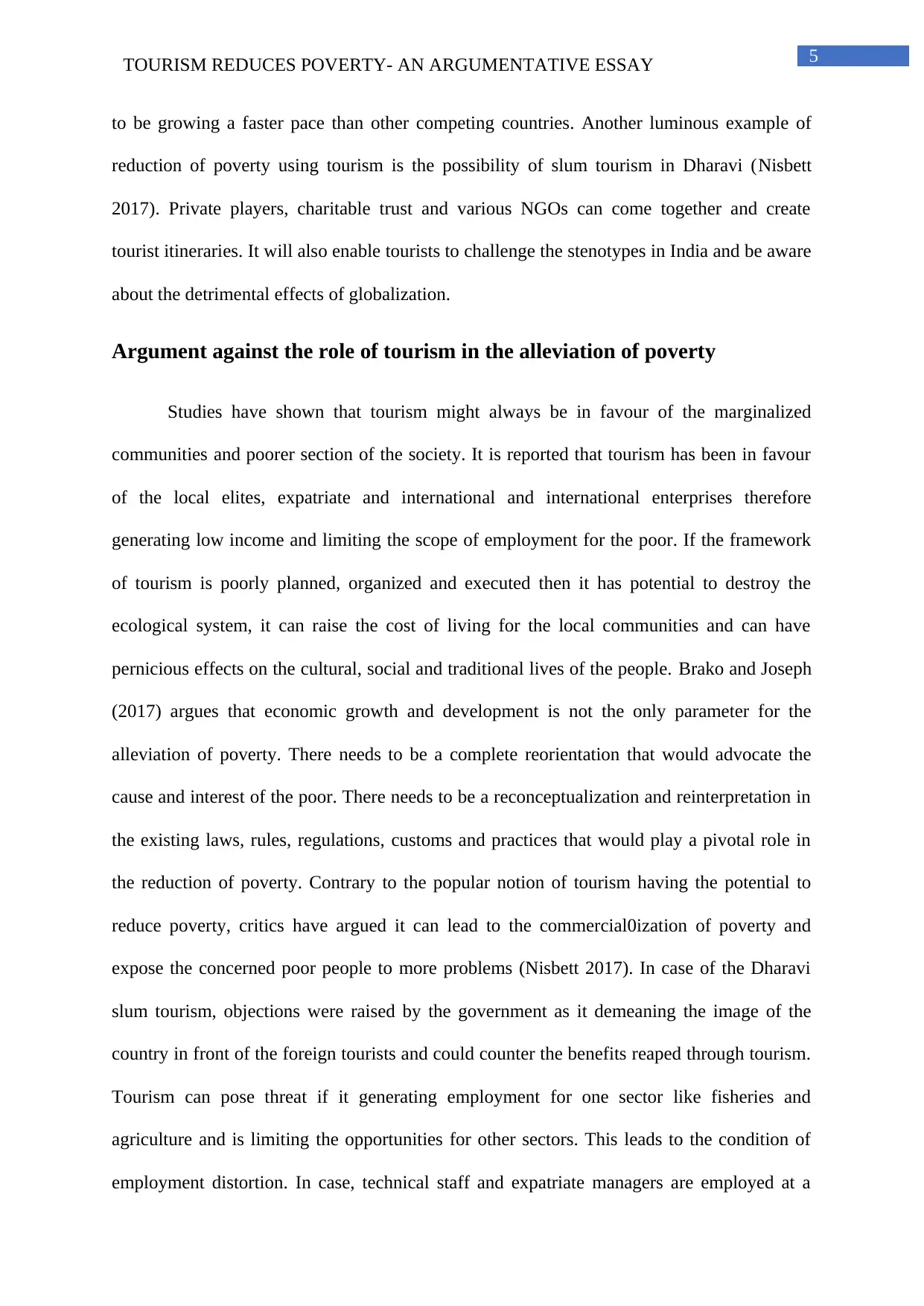
5TOURISM REDUCES POVERTY- AN ARGUMENTATIVE ESSAY
to be growing a faster pace than other competing countries. Another luminous example of
reduction of poverty using tourism is the possibility of slum tourism in Dharavi (Nisbett
2017). Private players, charitable trust and various NGOs can come together and create
tourist itineraries. It will also enable tourists to challenge the stenotypes in India and be aware
about the detrimental effects of globalization.
Argument against the role of tourism in the alleviation of poverty
Studies have shown that tourism might always be in favour of the marginalized
communities and poorer section of the society. It is reported that tourism has been in favour
of the local elites, expatriate and international and international enterprises therefore
generating low income and limiting the scope of employment for the poor. If the framework
of tourism is poorly planned, organized and executed then it has potential to destroy the
ecological system, it can raise the cost of living for the local communities and can have
pernicious effects on the cultural, social and traditional lives of the people. Brako and Joseph
(2017) argues that economic growth and development is not the only parameter for the
alleviation of poverty. There needs to be a complete reorientation that would advocate the
cause and interest of the poor. There needs to be a reconceptualization and reinterpretation in
the existing laws, rules, regulations, customs and practices that would play a pivotal role in
the reduction of poverty. Contrary to the popular notion of tourism having the potential to
reduce poverty, critics have argued it can lead to the commercial0ization of poverty and
expose the concerned poor people to more problems (Nisbett 2017). In case of the Dharavi
slum tourism, objections were raised by the government as it demeaning the image of the
country in front of the foreign tourists and could counter the benefits reaped through tourism.
Tourism can pose threat if it generating employment for one sector like fisheries and
agriculture and is limiting the opportunities for other sectors. This leads to the condition of
employment distortion. In case, technical staff and expatriate managers are employed at a
to be growing a faster pace than other competing countries. Another luminous example of
reduction of poverty using tourism is the possibility of slum tourism in Dharavi (Nisbett
2017). Private players, charitable trust and various NGOs can come together and create
tourist itineraries. It will also enable tourists to challenge the stenotypes in India and be aware
about the detrimental effects of globalization.
Argument against the role of tourism in the alleviation of poverty
Studies have shown that tourism might always be in favour of the marginalized
communities and poorer section of the society. It is reported that tourism has been in favour
of the local elites, expatriate and international and international enterprises therefore
generating low income and limiting the scope of employment for the poor. If the framework
of tourism is poorly planned, organized and executed then it has potential to destroy the
ecological system, it can raise the cost of living for the local communities and can have
pernicious effects on the cultural, social and traditional lives of the people. Brako and Joseph
(2017) argues that economic growth and development is not the only parameter for the
alleviation of poverty. There needs to be a complete reorientation that would advocate the
cause and interest of the poor. There needs to be a reconceptualization and reinterpretation in
the existing laws, rules, regulations, customs and practices that would play a pivotal role in
the reduction of poverty. Contrary to the popular notion of tourism having the potential to
reduce poverty, critics have argued it can lead to the commercial0ization of poverty and
expose the concerned poor people to more problems (Nisbett 2017). In case of the Dharavi
slum tourism, objections were raised by the government as it demeaning the image of the
country in front of the foreign tourists and could counter the benefits reaped through tourism.
Tourism can pose threat if it generating employment for one sector like fisheries and
agriculture and is limiting the opportunities for other sectors. This leads to the condition of
employment distortion. In case, technical staff and expatriate managers are employed at a
⊘ This is a preview!⊘
Do you want full access?
Subscribe today to unlock all pages.

Trusted by 1+ million students worldwide

6TOURISM REDUCES POVERTY- AN ARGUMENTATIVE ESSAY
higher rate, the local communities may express resentment on their loss. Another negative
aspect related to tourism is related to the seasonal nature of tourism and therefore, it is not a
sustainable option for the poor throughout the year (Mowforth and Munt 2015). Tourism
poses threat to the destruction of cultural assets and the degradation of the cultural resources.
In the broader context of the global issues related to the depletion of the resources and
degradation of the environment, tourism can have negative effect on the environment. As
noted by scholars, tourism as an industry demands a lot of expenditure and therefore, the lack
of engagement of the poor can reduce the attraction of tourism from the poor destinations.
Therefore, the income that would be generated would not benefit the poor but the affluent and
well-off sections of the society as consistent with the trickle effect. Since tourism is directly
proportional to the socio-cultural, political, environmental and economic condition, the
absence of social security and insurance can push the poor towards more vulnerable condition
(Vanegas, Gartner and Senauer 2015). This would be especially in a situation when there
would be the downswing of demand. Tourism may also lead to the increase in crime like drug
pedalling and trafficking. Many poor localities lack the adequate transport and
communication that is main basis of support for the growth of tourism
Conclusion
The main argument of the essay was that the tourism industry plays a significant role
in alleviation of poverty. The tourism industry creates employment for the local communities
and provides them an opportunity to introduce their culture and talent to the tourists. For the
developing countries, especially there is a need to boost the tourism industry and tap the
benefits reaped through it as foreign exchange will increase the Gross Nation Product (GNP)
of the country. The Kachchh region in Gujarat is a luminous example in this line as it has
created benefits for multiple stakeholders. However, thrust on tourism to alleviate poverty
can also have its detrimental effects. The advantages reaped through tourism might be limited
higher rate, the local communities may express resentment on their loss. Another negative
aspect related to tourism is related to the seasonal nature of tourism and therefore, it is not a
sustainable option for the poor throughout the year (Mowforth and Munt 2015). Tourism
poses threat to the destruction of cultural assets and the degradation of the cultural resources.
In the broader context of the global issues related to the depletion of the resources and
degradation of the environment, tourism can have negative effect on the environment. As
noted by scholars, tourism as an industry demands a lot of expenditure and therefore, the lack
of engagement of the poor can reduce the attraction of tourism from the poor destinations.
Therefore, the income that would be generated would not benefit the poor but the affluent and
well-off sections of the society as consistent with the trickle effect. Since tourism is directly
proportional to the socio-cultural, political, environmental and economic condition, the
absence of social security and insurance can push the poor towards more vulnerable condition
(Vanegas, Gartner and Senauer 2015). This would be especially in a situation when there
would be the downswing of demand. Tourism may also lead to the increase in crime like drug
pedalling and trafficking. Many poor localities lack the adequate transport and
communication that is main basis of support for the growth of tourism
Conclusion
The main argument of the essay was that the tourism industry plays a significant role
in alleviation of poverty. The tourism industry creates employment for the local communities
and provides them an opportunity to introduce their culture and talent to the tourists. For the
developing countries, especially there is a need to boost the tourism industry and tap the
benefits reaped through it as foreign exchange will increase the Gross Nation Product (GNP)
of the country. The Kachchh region in Gujarat is a luminous example in this line as it has
created benefits for multiple stakeholders. However, thrust on tourism to alleviate poverty
can also have its detrimental effects. The advantages reaped through tourism might be limited
Paraphrase This Document
Need a fresh take? Get an instant paraphrase of this document with our AI Paraphraser
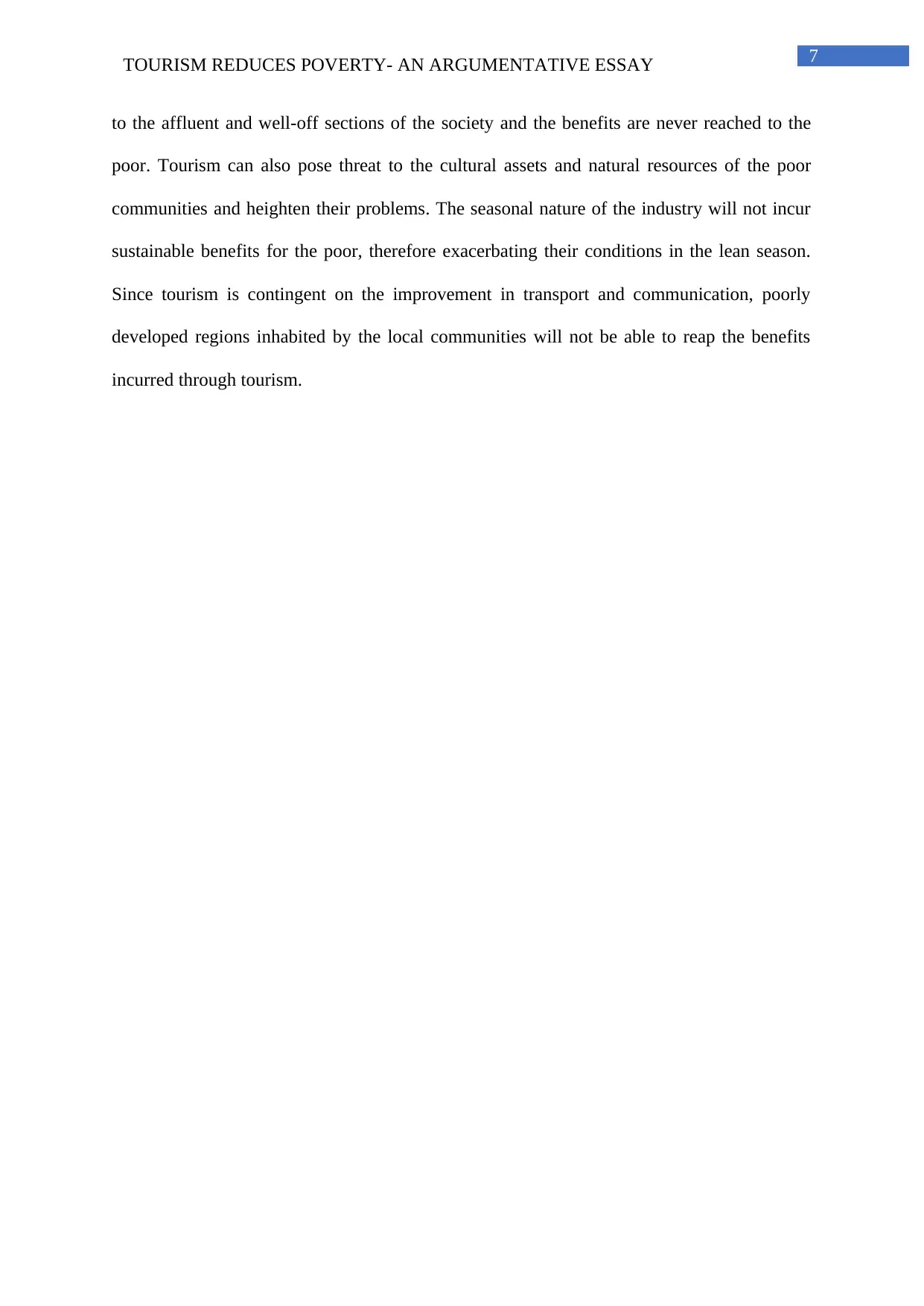
7TOURISM REDUCES POVERTY- AN ARGUMENTATIVE ESSAY
to the affluent and well-off sections of the society and the benefits are never reached to the
poor. Tourism can also pose threat to the cultural assets and natural resources of the poor
communities and heighten their problems. The seasonal nature of the industry will not incur
sustainable benefits for the poor, therefore exacerbating their conditions in the lean season.
Since tourism is contingent on the improvement in transport and communication, poorly
developed regions inhabited by the local communities will not be able to reap the benefits
incurred through tourism.
to the affluent and well-off sections of the society and the benefits are never reached to the
poor. Tourism can also pose threat to the cultural assets and natural resources of the poor
communities and heighten their problems. The seasonal nature of the industry will not incur
sustainable benefits for the poor, therefore exacerbating their conditions in the lean season.
Since tourism is contingent on the improvement in transport and communication, poorly
developed regions inhabited by the local communities will not be able to reap the benefits
incurred through tourism.
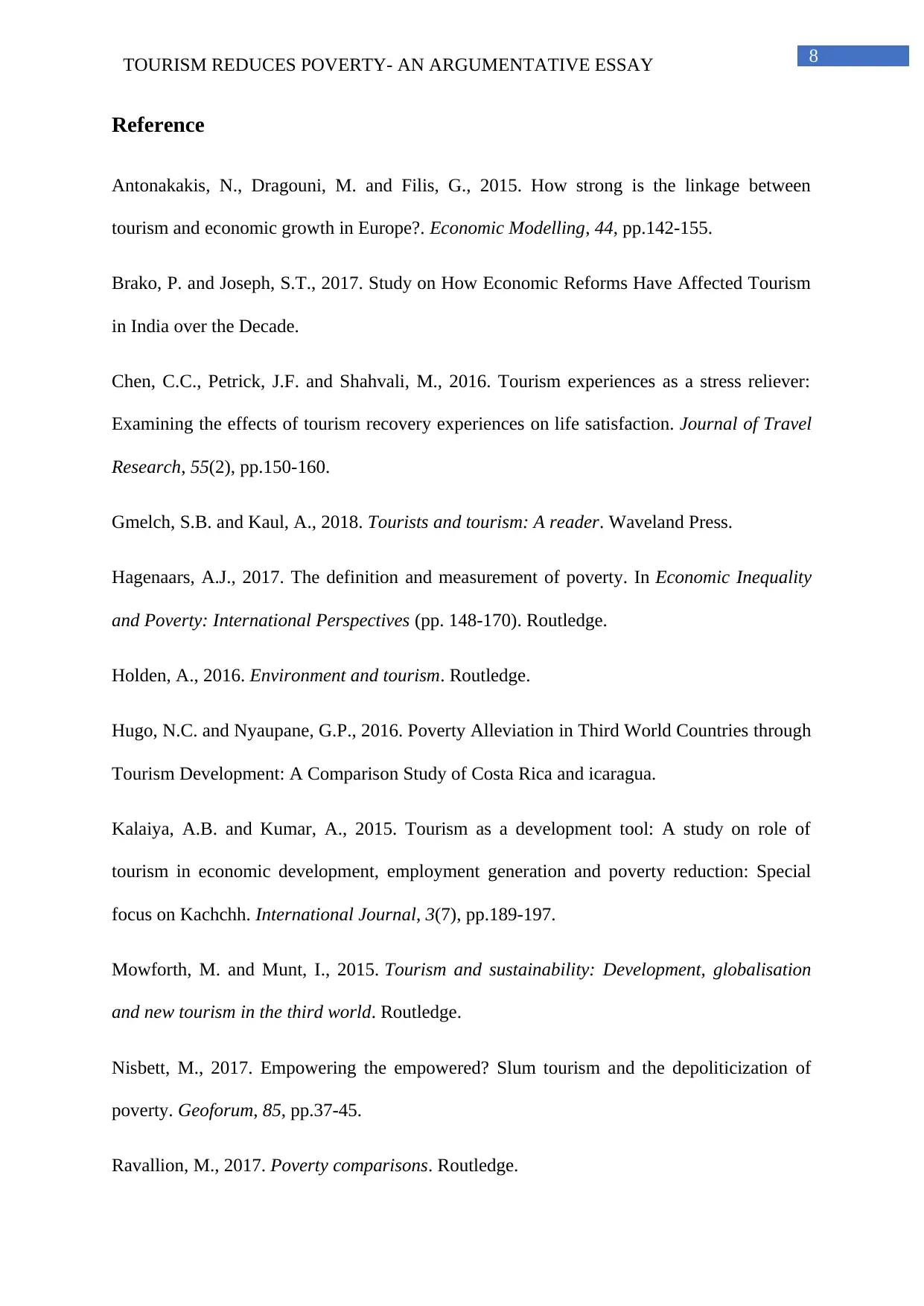
8TOURISM REDUCES POVERTY- AN ARGUMENTATIVE ESSAY
Reference
Antonakakis, N., Dragouni, M. and Filis, G., 2015. How strong is the linkage between
tourism and economic growth in Europe?. Economic Modelling, 44, pp.142-155.
Brako, P. and Joseph, S.T., 2017. Study on How Economic Reforms Have Affected Tourism
in India over the Decade.
Chen, C.C., Petrick, J.F. and Shahvali, M., 2016. Tourism experiences as a stress reliever:
Examining the effects of tourism recovery experiences on life satisfaction. Journal of Travel
Research, 55(2), pp.150-160.
Gmelch, S.B. and Kaul, A., 2018. Tourists and tourism: A reader. Waveland Press.
Hagenaars, A.J., 2017. The definition and measurement of poverty. In Economic Inequality
and Poverty: International Perspectives (pp. 148-170). Routledge.
Holden, A., 2016. Environment and tourism. Routledge.
Hugo, N.C. and Nyaupane, G.P., 2016. Poverty Alleviation in Third World Countries through
Tourism Development: A Comparison Study of Costa Rica and icaragua.
Kalaiya, A.B. and Kumar, A., 2015. Tourism as a development tool: A study on role of
tourism in economic development, employment generation and poverty reduction: Special
focus on Kachchh. International Journal, 3(7), pp.189-197.
Mowforth, M. and Munt, I., 2015. Tourism and sustainability: Development, globalisation
and new tourism in the third world. Routledge.
Nisbett, M., 2017. Empowering the empowered? Slum tourism and the depoliticization of
poverty. Geoforum, 85, pp.37-45.
Ravallion, M., 2017. Poverty comparisons. Routledge.
Reference
Antonakakis, N., Dragouni, M. and Filis, G., 2015. How strong is the linkage between
tourism and economic growth in Europe?. Economic Modelling, 44, pp.142-155.
Brako, P. and Joseph, S.T., 2017. Study on How Economic Reforms Have Affected Tourism
in India over the Decade.
Chen, C.C., Petrick, J.F. and Shahvali, M., 2016. Tourism experiences as a stress reliever:
Examining the effects of tourism recovery experiences on life satisfaction. Journal of Travel
Research, 55(2), pp.150-160.
Gmelch, S.B. and Kaul, A., 2018. Tourists and tourism: A reader. Waveland Press.
Hagenaars, A.J., 2017. The definition and measurement of poverty. In Economic Inequality
and Poverty: International Perspectives (pp. 148-170). Routledge.
Holden, A., 2016. Environment and tourism. Routledge.
Hugo, N.C. and Nyaupane, G.P., 2016. Poverty Alleviation in Third World Countries through
Tourism Development: A Comparison Study of Costa Rica and icaragua.
Kalaiya, A.B. and Kumar, A., 2015. Tourism as a development tool: A study on role of
tourism in economic development, employment generation and poverty reduction: Special
focus on Kachchh. International Journal, 3(7), pp.189-197.
Mowforth, M. and Munt, I., 2015. Tourism and sustainability: Development, globalisation
and new tourism in the third world. Routledge.
Nisbett, M., 2017. Empowering the empowered? Slum tourism and the depoliticization of
poverty. Geoforum, 85, pp.37-45.
Ravallion, M., 2017. Poverty comparisons. Routledge.
⊘ This is a preview!⊘
Do you want full access?
Subscribe today to unlock all pages.

Trusted by 1+ million students worldwide
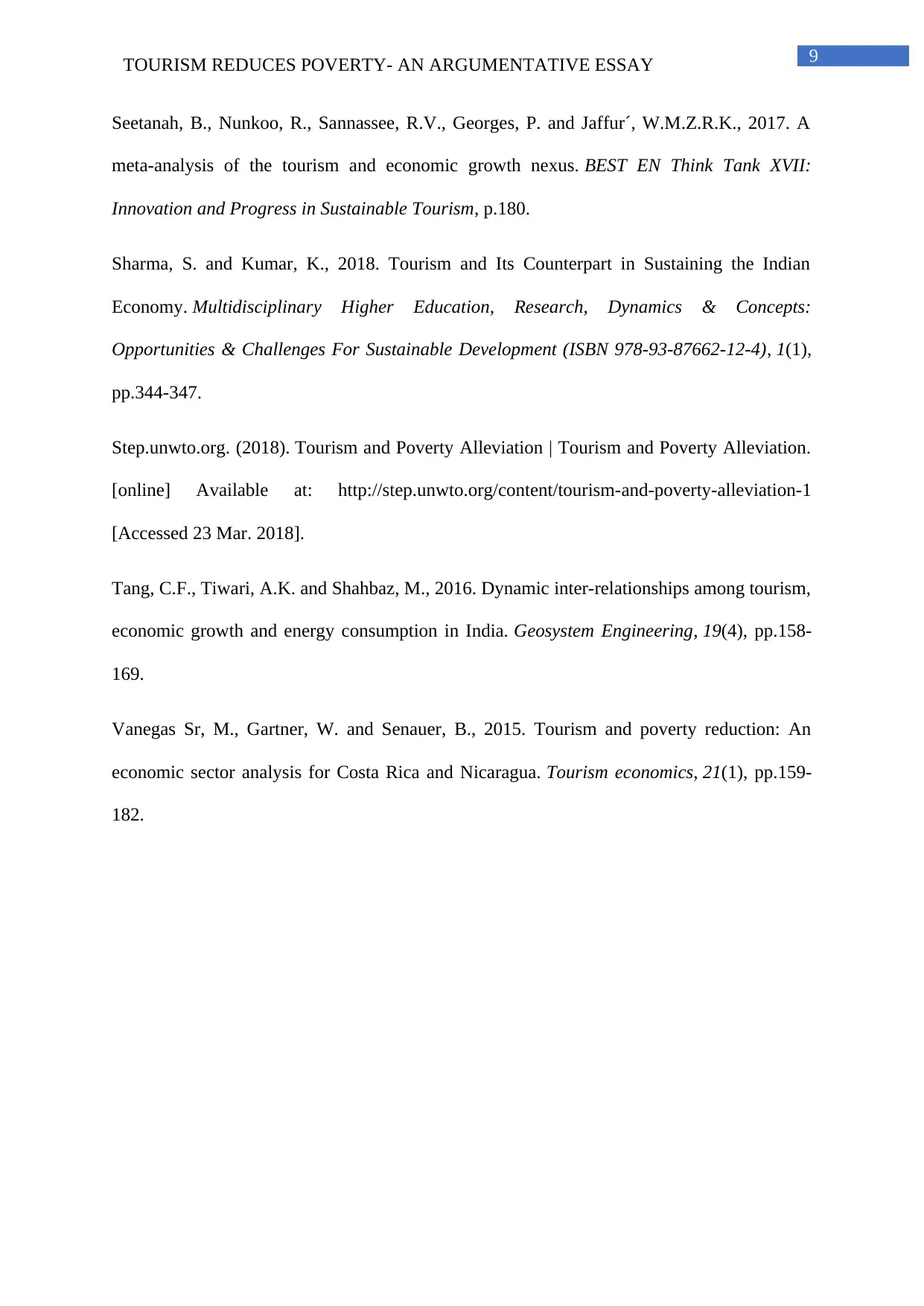
9TOURISM REDUCES POVERTY- AN ARGUMENTATIVE ESSAY
Seetanah, B., Nunkoo, R., Sannassee, R.V., Georges, P. and Jaffurˊ, W.M.Z.R.K., 2017. A
meta-analysis of the tourism and economic growth nexus. BEST EN Think Tank XVII:
Innovation and Progress in Sustainable Tourism, p.180.
Sharma, S. and Kumar, K., 2018. Tourism and Its Counterpart in Sustaining the Indian
Economy. Multidisciplinary Higher Education, Research, Dynamics & Concepts:
Opportunities & Challenges For Sustainable Development (ISBN 978-93-87662-12-4), 1(1),
pp.344-347.
Step.unwto.org. (2018). Tourism and Poverty Alleviation | Tourism and Poverty Alleviation.
[online] Available at: http://step.unwto.org/content/tourism-and-poverty-alleviation-1
[Accessed 23 Mar. 2018].
Tang, C.F., Tiwari, A.K. and Shahbaz, M., 2016. Dynamic inter-relationships among tourism,
economic growth and energy consumption in India. Geosystem Engineering, 19(4), pp.158-
169.
Vanegas Sr, M., Gartner, W. and Senauer, B., 2015. Tourism and poverty reduction: An
economic sector analysis for Costa Rica and Nicaragua. Tourism economics, 21(1), pp.159-
182.
Seetanah, B., Nunkoo, R., Sannassee, R.V., Georges, P. and Jaffurˊ, W.M.Z.R.K., 2017. A
meta-analysis of the tourism and economic growth nexus. BEST EN Think Tank XVII:
Innovation and Progress in Sustainable Tourism, p.180.
Sharma, S. and Kumar, K., 2018. Tourism and Its Counterpart in Sustaining the Indian
Economy. Multidisciplinary Higher Education, Research, Dynamics & Concepts:
Opportunities & Challenges For Sustainable Development (ISBN 978-93-87662-12-4), 1(1),
pp.344-347.
Step.unwto.org. (2018). Tourism and Poverty Alleviation | Tourism and Poverty Alleviation.
[online] Available at: http://step.unwto.org/content/tourism-and-poverty-alleviation-1
[Accessed 23 Mar. 2018].
Tang, C.F., Tiwari, A.K. and Shahbaz, M., 2016. Dynamic inter-relationships among tourism,
economic growth and energy consumption in India. Geosystem Engineering, 19(4), pp.158-
169.
Vanegas Sr, M., Gartner, W. and Senauer, B., 2015. Tourism and poverty reduction: An
economic sector analysis for Costa Rica and Nicaragua. Tourism economics, 21(1), pp.159-
182.
1 out of 10
Related Documents
Your All-in-One AI-Powered Toolkit for Academic Success.
+13062052269
info@desklib.com
Available 24*7 on WhatsApp / Email
![[object Object]](/_next/static/media/star-bottom.7253800d.svg)
Unlock your academic potential
Copyright © 2020–2025 A2Z Services. All Rights Reserved. Developed and managed by ZUCOL.



